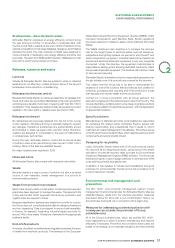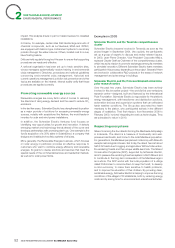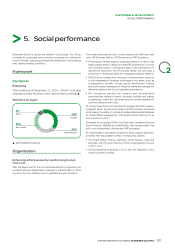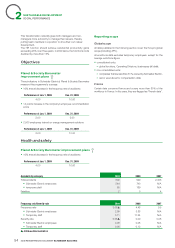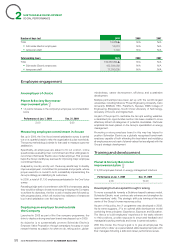APC 2009 Annual Report Download - page 52
Download and view the complete annual report
Please find page 52 of the 2009 APC annual report below. You can navigate through the pages in the report by either clicking on the pages listed below, or by using the keyword search tool below to find specific information within the annual report.
2009 REGISTRATION DOCUMENT SCHNEIDER ELECTRIC50
SUSTAINABLE DEVELOPMENT
2ENVIRONMENTAL PERFORMANCE
Measures to reduce energy consumption
At production sites
As its customers’ energy efficiency partner, Schneider Electric
applies its solutions in its own operations through the Energy Action
programme to reduce consumption. An integral part of the One
company programme , this initiative contributes directly to putting
energy effi ciency front and centre at Schneider Electric.
Energy Action’s key objectives include:
•cutting out waste of electricity, natural gas and oil, and thereby
reducing costs;
•deploying Schneider Electric’s energy effi ciency solutions at its
own sites so that customers can see them in operation;
•raising employees’ awareness about new energy efficiency
devices and their own contribution to product development.
The programme focuses on such key areas as HVAC; air
compressors, lighting and other equipment; and specifi c industrial
processes.
The Group met and in some cases exceeded its objective of reducing
energy consumption per production site employee by 10% between
2005 and 2008.
The goal now is to achieve an additional 10% reduction between
2009 and 2011, with a target of 3.5% for 2009.
A centralised initiative called Energy Effi ciency Monitoring (EEM)
has been introduced to support the programme , with the goal of
providing the various levels of management with a single scorecard
that displays the energy performance of all sites in the scope of
environmental reporting. Initially, the deployment roadmap is targeting
the 60 sites with the highest energy consumption. In 2010, all sites in
North America and certain sites in Europe will be connected.
Examples in 2009
Dubai, UAE – air conditioning and lighting management
Schneider Electric’s regional distribution centre in Jebel Ali, Dubai is
the Group’s product distribution and delivery hub for the Middle East.
Problem: managing the air conditioning and lighting systems
Because HVAC and lighting systems account for more than 70%
of the site’s energy consumption, they were targeted for immediate
improvement.
Solution
Additional PowerLogic meters were installed to supplement the
electricity metering devices already at the site and all the meters
were connected via a web gateway to a Web Energy remote control
system. The following measures were taken following an analysis of
the data collected and review of opportunities:
•a Zelio Logic module was installed to control the air conditioning
units and shut them down at night. The module also controls
the lighting systems and turns lights off when there is no activity;
•a number of unnecessary lighting systems in the warehouses were
shut down permanently.
Results and savings
The savings generated by these measures are estimated at more
than USD10,000, with a return on investment of less than six months.
Schneider Electric 38TEC site in Grenoble, France
Schneider Electric’s 38TEC campus in Grenoble is made up of four
buildings with offi ces and R&D and testing laboratories. Some 600
people work at the campus.
Problem: monitoring the hot water heating system pumps
The buildings are heated by a hot water heating system whose
pumps operate continuously at full capacity, no matter what the
occupants’ actual needs.
Solution
Schneider Electric speed drives were installed on the main circuit’s
pumps to regulate them based on the demand for heat.
Results and savings
This simple yet effective solution has substantially reduced the
pumps’ energy consumption. In January and February2009,
electricity use was down 67% from the year-earlier period, even
though outside temperatures were 25% lower.
Schneider Electric Low Voltage, Tianjin, China
This site, with nearly 850 employees, is primarily devoted to the
production of the Multi 9 miniature circuit breaker family.
Problem: lighting and air conditioning
Because the lighting system did not have sector control or
programming timers, lights often stayed on when no longer needed
and it was diffi cult to turn on a selected group of lights.
In addition, the air conditioning system consumed more energy than
necessary.
Solution
Lighting control systems were installed to manage the lights by
sector and programme weekly schedules. Energy saving devices
were also added to the lighting systems. Lastly, speed drives were
installed in the air conditioning ventilation systems to optimise energy
use.
Results and savings
These measures have cut energy use by around 200MWh a year
and reduced the energy bill by around 6%.
Promoting energy efficiency
The Group has launched numerous in-house initiatives to explain
the short and long-term benefi ts of energy effi ciency. These include
awareness campaigns, the election of “energy champions” in each
country, the formation of local working groups to deploy Energy
Action measures at their sites, and recognition for the most energy
effi cient employee and site. A dedicated intranet site keeps the
corporate community informed of Energy Action’s progress and
results.
Events and symposiums have been organised in France, the UK,
South Korea, Turkey, South Africa, Singapore and the US for
customers and partners.
Examples in 2009
United States – Solar Decathlon
This competition, open exclusively to universities, is organised by
the US Department of Energy to stimulate emulation, innovation,
knowledge sharing and research in the area of renewable energies.
Areas of focus include zero-energy homes and solar energy.
Examples of passive solar homes and homes that produce energy
are on exhibit in Washington D.C. As a sustainable sponsor,
Schneider Electric provided participants with solutions and services
to link the homes to the city’s power grid, along with numerous
other products.













